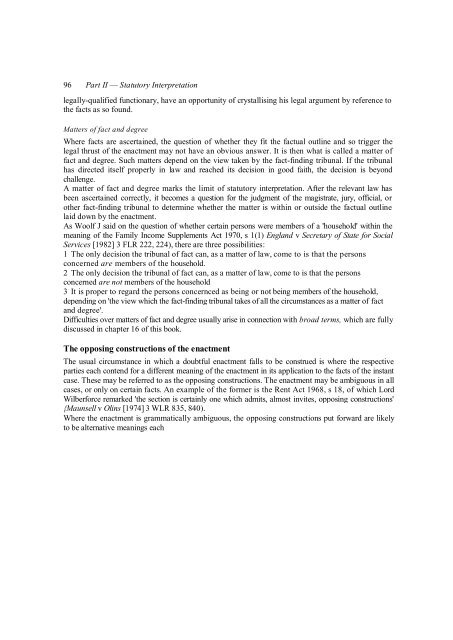Statutory Interpretation The Technique of Statutory ... - Francis Bennion
Statutory Interpretation The Technique of Statutory ... - Francis Bennion
Statutory Interpretation The Technique of Statutory ... - Francis Bennion
Create successful ePaper yourself
Turn your PDF publications into a flip-book with our unique Google optimized e-Paper software.
96 Part II — <strong>Statutory</strong> <strong>Interpretation</strong><br />
legally-qualified functionary, have an opportunity <strong>of</strong> crystallising his legal argument by reference to<br />
the facts as so found.<br />
Matters <strong>of</strong> fact and degree<br />
Where facts are ascertained, the question <strong>of</strong> whether they fit the factual outline and so trigger the<br />
legal thrust <strong>of</strong> the enactment may not have an obvious answer. It is then what is called a matter <strong>of</strong><br />
fact and degree. Such matters depend on the view taken by the fact-finding tribunal. If the tribunal<br />
has directed itself properly in law and reached its decision in good faith, the decision is beyond<br />
challenge.<br />
A matter <strong>of</strong> fact and degree marks the limit <strong>of</strong> statutory interpretation. After the relevant law has<br />
been ascertained correctly, it becomes a question for the judgment <strong>of</strong> the magistrate, jury, <strong>of</strong>ficial, or<br />
other fact-finding tribunal to determine whether the matter is within or outside the factual outline<br />
laid down by the enactment.<br />
As Woolf J said on the question <strong>of</strong> whether certain persons were members <strong>of</strong> a 'household' within the<br />
meaning <strong>of</strong> the Family Income Supplements Act 1970, s 1(1) England v Secretary <strong>of</strong> State for Social<br />
Services [1982] 3 FLR 222, 224), there are three possibilities:<br />
1 <strong>The</strong> only decision the tribunal <strong>of</strong> fact can, as a matter <strong>of</strong> law, come to is that the persons<br />
concerned are members <strong>of</strong> the household.<br />
2 <strong>The</strong> only decision the tribunal <strong>of</strong> fact can, as a matter <strong>of</strong> law, come to is that the persons<br />
concerned are not members <strong>of</strong> the household<br />
3 It is proper to regard the persons concernced as being or not being members <strong>of</strong> the household,<br />
depending on 'the view which the fact-finding tribunal takes <strong>of</strong> all the circumstances as a matter <strong>of</strong> fact<br />
and degree'.<br />
Difficulties over matters <strong>of</strong> fact and degree usually arise in connection with broad terms, which are fully<br />
discussed in chapter 16 <strong>of</strong> this book.<br />
<strong>The</strong> opposing constructions <strong>of</strong> the enactment<br />
<strong>The</strong> usual circumstance in which a doubtful enactment falls to be construed is where the respective<br />
parties each contend for a different meaning <strong>of</strong> the enactment in its application to the facts <strong>of</strong> the instant<br />
case. <strong>The</strong>se may be referred to as the opposing constructions. <strong>The</strong> enactment may be ambiguous in all<br />
cases, or only on certain facts. An example <strong>of</strong> the former is the Rent Act 1968, s 18, <strong>of</strong> which Lord<br />
Wilberforce remarked 'the section is certainly one which admits, almost invites, opposing constructions'<br />
{Maunsell v Olins [1974] 3 WLR 835, 840).<br />
Where the enactment is grammatically ambiguous, the opposing constructions put forward are likely<br />
to be alternative meanings each

















